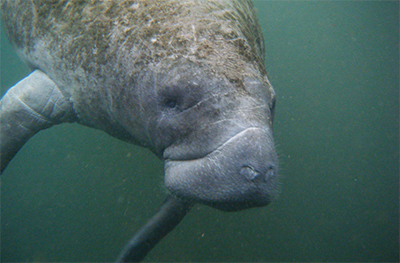Shadow gene makes sea mammals vulnerable
After the forerunners of modern whales, dolphins and manatees independently turned their backs on terrestrial lives tens of millions of years ago, their descendants soon lost the function of PON1, a gene whose encoded enzyme, paraoxonase, reduces oxidative damage to lipid particles in mammals’ bloodstreams. In losing the function of that enzyme, whose gene still lingers, wraithlike, in the animals’ genetic code, a vast number of marine mammals also lost its serendipitous secondary ability to break down a neurotoxic metabolite of the pesticide chlorpyrifos.

Experts estimate that manatees’ mammalian ancestors began adapting to aquatic life around 60 million years ago, whereas the forebears that became both dolphins and whales returned to the ocean nearly 50 million years ago.Courtesy of Robert Engberg/ Flickr If you’ve ever dreamed of being born anew as a sea otter or other marine mammal, you may be in for a neurotoxic surprise.
More than 50 years after Dow Chemical Company introduced chlorpyrifos to the market, it continues to be one of the most widely used insecticides in the United States, although it was banned from residential use in 2000. That ban came on the heels of highly publicized cases of chlorpyrifos poisoning in the ’90s that left a West Virginia child paralyzed and a Texas man in a vegetative state.
The 9th Circuit Court of Appeals in Seattle in August ordered the Environmental Protection Agency to a ban the pesticide from agricultural use within 60 days. The court’s decision, a rebuke to the agency after former EPA chief Scott Pruitt denied an environmental group’s petition to ban the use of chlorpyrifos on food crops, coincidentally was made public less than an hour after a study on the marine mammals’ loss of PON1 function was published in the journal Science.
Clement Furlong, a biochemist at the University of Washington and co-author on the paper, applauded the court’s action.
“The decision to discontinue the use of chlorpyrifos was based on very solid scientific evidence from many different laboratories, and the (initial) decision to discontinue the ban was certainly not,” Furlong said. “It’s to the benefit of sensitive humans, particularly the very young, and animals that have no protection, including the marine mammals, birds, fish, other animals that are missing the paraoxonase function.”
 Sea otters are among the marine mammals that Nathan Clark and colleagues found to have lost production of an antioxidant enzyme that also breaks down organophosphate pesticides.Courtesy of Neil Hooting/FlickrIn addition to sirenians, the taxonomic order containing manatees and the extinct Steller’s sea cow, and cetaceans, the order containing dolphins, whales and porpoises, the researchers found that North American beavers as well as pinnipeds such as the Weddell seal, Hawaiian monk seal and elephant seal, lost function of the PON1 gene. Senior author Nathan Clark believes this may have been an adaptation to the oxidative stresses caused by prolonged diving.
Sea otters are among the marine mammals that Nathan Clark and colleagues found to have lost production of an antioxidant enzyme that also breaks down organophosphate pesticides.Courtesy of Neil Hooting/FlickrIn addition to sirenians, the taxonomic order containing manatees and the extinct Steller’s sea cow, and cetaceans, the order containing dolphins, whales and porpoises, the researchers found that North American beavers as well as pinnipeds such as the Weddell seal, Hawaiian monk seal and elephant seal, lost function of the PON1 gene. Senior author Nathan Clark believes this may have been an adaptation to the oxidative stresses caused by prolonged diving.
“If we pump up our bodies with tons of oxygen, submerge, deplete all that oxygen and then come back and rapidly reperfuse our bodies with oxygen, proteins and DNA and lipids would just be oxidized like crazy, and that would cause a lot of damage, and we would not survive very long,” Clark said.
To deal with the stress, marine mammals have evolved to pump out high amounts of the antioxidants catalase and superoxide dismutase.
“So one thought is that if their upfront defenses for free radical-producing things that would cause oxidative damages are so strong, then maybe PON1 is no longer necessary,” Clark said.
While it is unclear when PON1 evolved, the gene is believed to be ubiquitous among land mammals due to the role it plays in preventing the buildup of arterial plaques. Fish and birds lack PON1, and their populations consequently have been devastated by chlorpyrifos, whose metabolite chlorpyrifos oxon disrupts acetylcholine activity at nerve terminals.
Clark and his colleagues discovered that marine mammals had lost PON1’s functionality by scouring the protein-coding sequences of more than 17,000 genes in 60 species for signs that genes had become nonfunctional pseudogenes through the addition of early stop codons and frameshift mutations. They tabulated the results in a matrix and used phylogenetic software to score each gene on how quickly it was lost in a species.
“Physiologists and marine biologists have known for decades that dolphins and whales have no sense of smell, so we thought we’d see a lot of chemosensation genes like olfactory receptors, and we did,” said Clark, a comparative genomicist at the University of Pittsburgh. “Some of our expectations didn’t come out, but then this gene Paraoxonase 1 was sitting right on top of the list.”
Margaret Hunter, a research geneticist at the U.S. Geological Survey’s Wetland and Aquatic Research Center in Gainesville, Florida, who was not an author on the study, is also intrigued at the scope of PON1’s loss of function.
“I thought it was quite surprising, and a pretty interesting find, especially because of the breadth of the mutation in the different species,” she said. “And the evolutionary divergence of all of these animals is extremely broad too, all the way to sirenians, which originated in Africa and are related to elephants and hyraxes.”
Hunter, who specializes in manatee population genetics, said the gene’s loss of function might be less heavily tied to diving, given PON1’s loss in manatees and their preference for coastal waters.
“We’ll see them sometimes at 20 feet, but they really prefer shallower waters,” she said. “They do hold their breath, so that could be related to it, but it is pretty interesting because they’re not diving or holding their breath for a length that we see in some other cetaceans or pinnipeds.”
Clark and his colleagues plan to examine a greater number of marine mammals in their next analysis and begin collaborations with ecologists in Florida to monitor manatees for the presence of chlorpyrifos, which, despite the court-ordered ban, likely will remain in agricultural runoff in the U.S. for the near future.
“Just because you ban a pesticide doesn’t mean it’s removed from the environment very rapidly,” Hunter said. “We still need to monitor populations for these pesticides moving forward.”
Enjoy reading ASBMB Today?
Become a member to receive the print edition four times a year and the digital edition monthly.
Learn moreGet the latest from ASBMB Today
Enter your email address, and we’ll send you a weekly email with recent articles, interviews and more.
Latest in Science
Science highlights or most popular articles

Gut microbes hijack cancer pathway in high-fat diets
Researchers at the Feinstein Institutes for Medical Research found that a high-fat diet increases ammonia-producing bacteria in the gut microbiome of mice, which in turn disrupts TGF-β signaling and promotes colorectal cancer.

Mapping fentanyl’s cellular footprint
Using a new imaging method, researchers at State University of New York at Buffalo traced fentanyl’s effects inside brain immune cells, revealing how the drug alters lipid droplets, pointing to new paths for addiction diagnostics.

Designing life’s building blocks with AI
Tanja Kortemme, a professor at the University of California, San Francisco, will discuss her research using computational biology to engineer proteins at the 2026 ASBMB Annual Meeting.

Cholesterol as a novel biomarker for Fragile X syndrome
Researchers in Quebec identified lower levels of a brain cholesterol metabolite, 24-hydroxycholesterol, in patients with fragile X syndrome, a finding that could provide a simple blood-based biomarker for understanding and managing the condition.

How lipid metabolism shapes sperm development
Researchers at Hokkaido University identify the enzyme behind a key lipid in sperm development. The findings reveal how seminolipids shape sperm formation and may inform future diagnostics and treatments for male infertility.

Mass spec method captures proteins in native membranes
Yale scientists developed a mass spec protocol that keeps proteins in their native environment, detects intact protein complexes and tracks drug binding, offering a clearer view of membrane biology.

